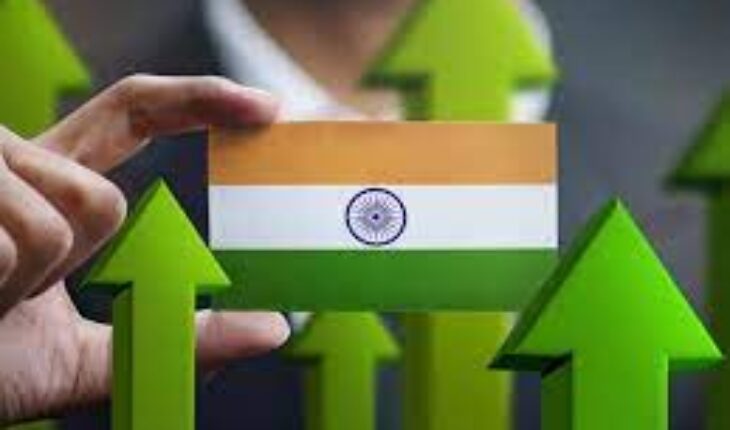
In a recent address to the American Congress, Prime Minister Modi predicted that by the year 2028, India’s GDP would overtake the United States as the third-largest in the world. This statement has given all Indians a chance to be proud of the economic advancement of their nation and has also ingnited aspirations for new dreams.It is worth noting that last year, India had achieved the distinction of being the world’s fifth-largest economy based on its GDP size. Today, India ranks only behind United States, China ,Japan and Germany . The facts supporting Prime Minister Modi’s vision of India becoming the third-largest economy by 2028 are also corroborated by a recent report released by International Monetary Fund.According to this report, by the year 2028, the size of the Indian economy will be equivalent to 5.58 trillion US dollars, placing India on the third spot globally. Japan will be at the fourth position with 5.34 trillion US dollars, and Germany at the fifth position with 5.04 trillion US dollars. This indicates that the recent report by the International Monetary Fund is paving the way for India to stand as the world’s third major power in the coming five years. However, it is essential to understand that during the same period, China’s GDP will be around 27.49 trillion dollars, and the United States’ GDP will be approximately 32.35 trillion dollars. In other words, China will be more than five times larger than India, while the United States will be more than six times larger. Therefore, discussions about India becoming the world’s third-largest power also revolve around the fact that it will still be significantly smaller in comparison to the United States and China.Another observation is that Japan and Germany will not be too far behind India and, due to their technological prowess, may gain an advantage over India in the future. On the other hand, it will be challenging for India, being a country with the world’s largest population, to increase individual income at the domestic level based on GDP size.
This is not just a feeling, but the reality is that in the current scenario, comparing India to United States appears to be merely a dream. America holds dominion in the field of technology worldwide and its share in the GDP of all countries has been more than a quarter for the past several years. According to the report of the International Monetary Fund on December 31, 2022, the size of the GDP of all economies in the world has now exceeded 100 trillion US dollars, which was only about 34 trillion US dollars in the year 2000. In the past 22 years, the GDP of all economies in the world has tripled, and among them, the United States has retained its top position, contributing to over a quarter of the GDP of all economies.
Now, if we talk about China, it has experienced an unexpected growth in its economic level in the last 15-20 years, and perhaps that’s the reason why the GDP of all major economies in the world has increased rapidly, by three times. India competes with China, while China firmly believes that India is not even in competition with it. Perhaps China’s argument behind this is that India heavily depends on imports from China, and India’s trade deficit with China is nearly 100 billion dollars. Trade deficit implies that India imports much more from China compared to its exports to China. It is also worth mentioning that India’s defense budget at present is less than its trade deficit with China.
Over the past 30 years, after making significant changes in its economic development policies, India has consistently maintained a good pace of economic growth. Despite various global economic crises and challenges that emerged from time to time, India has continuously boosted the size of its economy. As per statistics, in 1991, the size of the Indian economy was just $0.3 trillion, which increased to $0.52 trillion by 2004. During this period, India was moving forward with new economic reforms, but at the same time, it faced several global economic sanctions due to its nuclear tests in Pokhran, which lasted for several years.
In the political context, this was the time when coalition governments became prevalent in India. Despite that, India achieved remarkable economic growth. From 2003-04 to 2013-14, during Manmohan Singh’s tenure, India’s GDP reached $1.86 trillion. In this period, India also faced the impact of the 2007 US recession, which was a global crisis. Later, during the Modi era, from 2013-14 to 2022, the Indian economy reached the $3.39 trillion mark, becoming the world’s fifth-largest economy.Now, as of 2023, the IMF has estimated India’s GDP size to be around $3.75 trillion. India’s economic journey in the last three decades has been impressive, instilling confidence that it will undoubtedly emerge as the world’s third-largest economic power in the coming years. Based on this, Prime Minister Modi recently addressed the US Congress, highlighting India’s achievements and aspirations in this context.
The dream of becoming the third-largest economic powerhouse is undoubtedly a delightful experience. However, it is essential to analyze why China and the United States are surging ahead rapidly. If we consider the data of the past three years, India’s economy has grown only from $2.84 trillion to $3.39 trillion, an increase of a mere $0.55 trillion. In contrast, China and the United States have increased their GDP sizes to $3.76 trillion and $4.08 trillion, respectively. This comparison undoubtedly raises concerns, as India’s current GDP level of $3.39 trillion is still lower than the growth experienced by both these nations in the past four years. To understand the relative slowdown in India’s economic growth, we must consider what happened in recent years that diminished its pace compared to China and the United States. Otherwise, India could have been much ahead today, and the dream of becoming the third-largest economic powerhouse by 2028 might have been realized earlier. Upon analysis, one fact becomes apparent: in the past four years, the Indian Rupee has significantly weakened against the American Dollar. The figures indicate that in December 2019, one US Dollar was equivalent to ₹59, whereas by December 31, 2022, it had risen to around ₹83, a depreciation of approximately 20% during this period.In contrast, the Chinese currency, the Yuan, did not experience such a substantial depreciation against the US Dollar, and as a result, China’s GDP has grown at a much faster rate in recent years. It is evident that the weakness of the Indian Rupee is a significant factor behind the rising import costs and soaring inflation levels in the domestic market, which have profoundly affected individual economic development.
In the coming years, it is not an exaggeration to say that India will become the world’s third-largest economic powerhouse. However, during that time, India will remain significantly weaker compared to China and the United States. It is evident that in the times ahead, India’s economic policies will undergo substantial changes again. This is because India is now the most populous country in the world, and there will be a need to explore several new approaches to address the issues of unemployment and inflation at the domestic level.Nevertheless, the credit for India’s economic progress in the last three decades goes to the economic reforms of the 1990s, which rapidly propelled India to the position of the world’s fifth-largest economic power and set it on course to become the third-largest in the near future. It is also worth noting that from 1991 to 2014, the Indian economy achieved an average growth rate of 7.81 percent, which is highly commendable. Moreover, if we look at the period from 2004 to 2014, the growth rate was even higher, surpassing 13 %.However, since 2014, the size of the GDP has increased significantly, but the growth rate has hovered around 6 percent, which is a cause for concern. Nevertheless, it should not be viewed entirely negatively, as during this period, several economic reforms, including the introduction of GST, have taken place in India. Additionally, the unexpected economic impacts of the COVID-19 pandemic have also hindered economic development for about one and a half years.
Dr. P.S. Vohra , Academician, Financial Thinker & Newspaper Columnist , Views are personal






